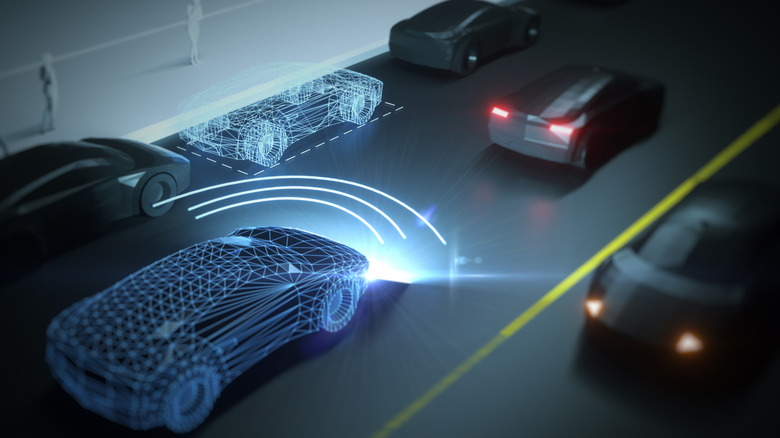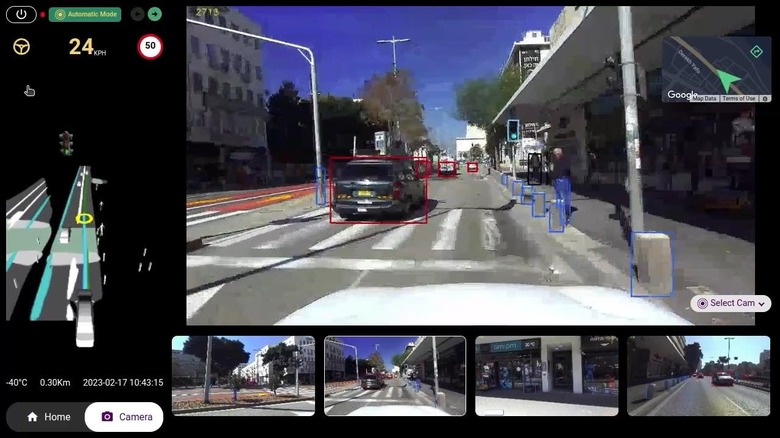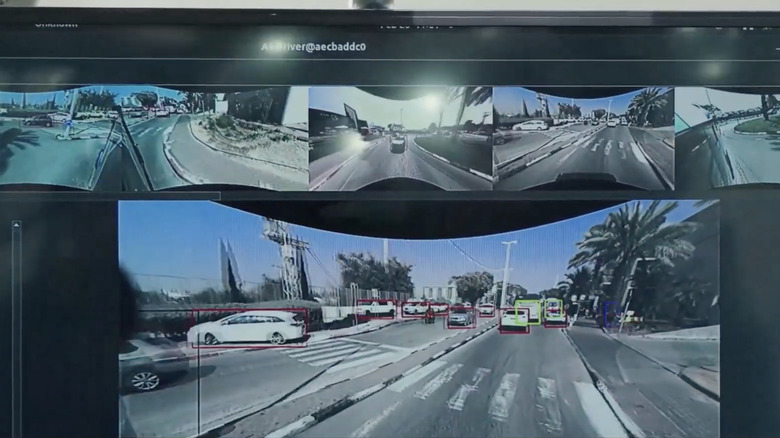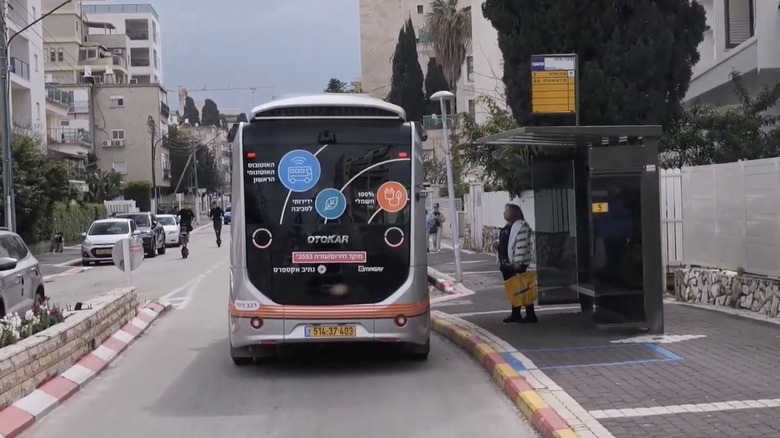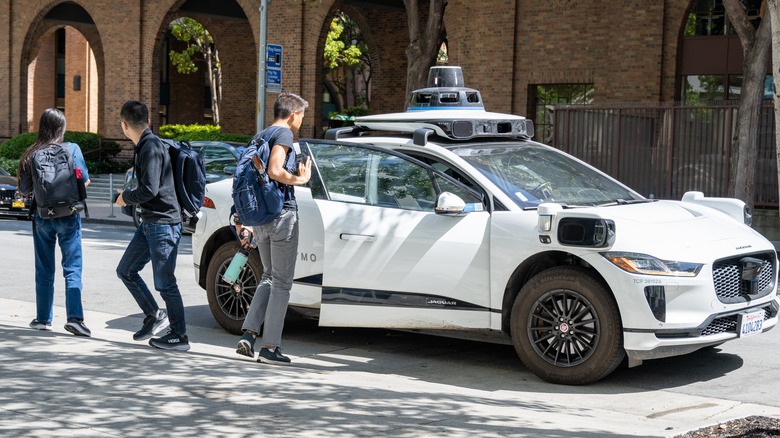This CES Tech Could Be A Practical Boon For Self-Driving Cars, At Last
Autonomous vehicle technology is often portrayed as a godsend. Among the key benefits is that it will bestow upon older people "greater mobility, autonomy, quality of life and participation in society." Then there is the accessibility aspect, which also stands to create remarkable utility. "Partially and fully autonomous cars, for example, could enable people who are no longer able to drive a car themselves to be mobile," according to an analysis by experts at the Austrian Institute of Technology, with some caveats. "There must be no excessive demands made on them by the technology," it adds.
Given the current state of the industry — where even a leading company like Tesla attached an "always be ready to take over" condition on its self-driving system — the perceived benefits seem conditional. Then we have the younger base of drivers. In a survey by auto insurer State Farm and Students Against Destructive Decisions, over 60% said they wouldn't get or move in a self-driving car citing safety reasons. "In comparison with adult drivers, young drivers are substantially over-involved in crashes," says the National Highway Traffic Safety Administration.
That's where Imagry and its Safe Driver Overwatch tech enters the picture. Announced earlier this year, the system would essentially act like a self-disciplined situation-aware control system for autonomous cars. CEO Eran Ofir tells SlashGear that the tech is a guardian angel, especially for new drivers and old folks with diminishing capabilities.
Safe Driver Overwatch: What does it do?
Imagry's tech is best described in the company's own words. "By providing real-time assistance and enforcing responsible driving behaviors, such as adherence to speed limits and traffic signals, Safe Driver Overwatch acts as a virtual co-pilot, helping to reduce the risk of accidents and keep teen drivers safe on the road," one of its social posts reads.
Imagry notes Safe Driver Overwatch is for learning drivers those that have seen their skills erode due to age. There are three core operational aspects here. First, the system will tone down the maximum speed of a car and will subsequently make sure that the car doesn't exceed that pace. It will also be situationally aware. For example, if the weather is risky, the route ahead has active construction, or in congested zones, the speed will be limited to lessen any risks.
The system also keeps track of traffic signals and road signs. Depending on the signs it comes across, it will accordingly adjust the car's speed or bring it to a stop. The most promising element of the tech stack is Pedestrian Anticipation. It "anticipates pedestrian movement," says Imagry. Based on how it reads and predicts the movement of the people around it, the car will accordingly adjust its course. The company claims its Pedestrian Anticipation system can spot jaywalkers and people on designated crosswalks alike.
How Imagry's tech could be a game changer?
On the surface, Imagry's Safe Driver Overwatch might not sound groundbreaking. But there is plenty of research that suggests we could use a proactive safety solution for autonomous cars, especially in the wake of fatal incidents involving the likes of Tesla's Autopilot tech. Systemic or incidental failures of self-driving cars would require an urgent takeover by the person behind the wheels, but mobility issues affecting the elderly or new drivers might not always allow that in high-stakes situations.
"There are still some situations where the car would ask the driver to take back control and at that point, they need to be switched on and back in driving mode within a few seconds," notes Dr. Shou Li from Newcastle University, following research that involved testing the DriveLAB simulator on two different age groups. Imagry CEO Eran Ofir says they've driven several hundred thousand kilometers and "haven't caused a single scratch."
"For younger people that switch between tasks is quite easy but as we age, it becomes increasingly more difficult and this is further complicated if the conditions on the road are poor," adds Li, who is an expert in the field of intelligent transport systems. During a hands-on analysis, the team reported that older drivers (60 to 81 years of age) aren't particularly suited for taking command of their cars. This boosts the chances of an accident. Imagry's Self Drive Overwatch could be a lifesaver by reducing the speed and being proactively aware of its surroundings.
An amazing premise
"The function is supplied as software to be integrated into the car's existing computing system," Ofir tells SlashGear, adding that the tech is hardware-agnostic. That takes out the critical hardware engineering burden from the deployment equation. Moreover, it will work for electric and ICE vehicles just fine. Ofir notes it has tested the tech in both cars and buses in the U.S., Germany, Israel, and Japan among others, but has not received any certification by a government-certified agency.
Being proactive is another aspect that sets the Safe Driver Overwatch system apart. "With the Imagry technology, the driver is prevented from performing illegal maneuvers, not simply alerted," he adds. Intention mapping of pedestrians is another standout feature. Imagry tells us that using the 360-degree imaging hardware on a vehicle, the system identifies a person's body posture, and calculates their pace, trajectory, and safe distance from the vehicle.
Think of it as creating a real-time map and then accordingly adjusting the motion parameters of a vehicle. "This advanced capability is designed to enhance safety by ensuring responsible and rule-abiding driving behavior. It's a game-changer for families with teen or elderly drivers," Ofir notes. He further points out that insurance companies should be the first to embrace the technology "as it is certain to reduce the number of accidents caused by unsure drivers."
The perception problem
A transportation research journal article recently highlighted the apprehensions of older drivers when it comes to the safety of self-driving vehicles. Analysis by Pew Research Center mentioned a similar cautionary attitude towards autonomous cars among Americans who are 50 or older. A qualitative analysis published in the Geriatrics journal also noted a "proven safety record" as one of the core requisites for the older generation to put their focus on fully-autonomous vehicles.
It's, therefore, not surprising that older people put more trust in lesser advanced (SAE Level 2) autonomous vehicles due to safety concerns, according to this Frontiers paper. The situation with teens is no less tricky. Another paper notes that teens "expressed concerns in relation to the interactions with other road users, to automated driving systems' reliability, to safety, and to data privacy." CHOP Research Institute also recommends that self-driving vehicles will need more proactive safety measures — like the one in development at Imagry — to taste success among teenagers.
Right now, automakers are taking cautious approaches with ADAS tech. While that sounds positive, it puts the onus of a safe ride on the person behind the wheel, requiring them to stay vigilant and be ready to wrest back control at all times. That essentially beats the purpose of self-driving tech. With the status quo being such, self-driving tech could use a stop-gap solution like Imagry's Safe Driver Overwatch solution for an added dash of safety for the vulnerable segment.
